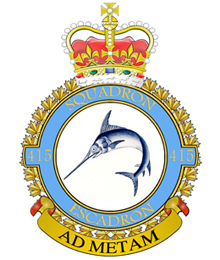
The Battle of Britain was a military campaign of the Second World War, in which the Royal Air Force (RAF) defended the United Kingdom (UK) against large-scale attacks by Nazi Germany's air force, the Luftwaffe. It has been described as the first major military campaign fought entirely by air forces. The British officially recognise the battle's duration as being from 10 July until 31 October 1940, which overlaps the period of large-scale night attacks known as The Blitz, that lasted from 7 September 1940 to 11 May 1941. German historians do not accept this subdivision and regard the battle as a single campaign lasting from July 1940 to June 1941, including the Blitz.

Royal Air Force Brize Norton or RAF Brize Norton in Oxfordshire, about 75 mi (121 km) west north-west of London, is the largest station of the Royal Air Force. It is close to the settlements of Brize Norton, Carterton and Witney.

The Handley Page HP.52 Hampden was a British twin-engine medium bomber of the Royal Air Force (RAF). It was part of the trio of large twin-engine bombers procured for the RAF, joining the Armstrong Whitworth Whitley and Vickers Wellington. The newest of the three medium bombers, the Hampden was often referred to by aircrews as the "Flying Suitcase" because of its cramped crew conditions. The Hampden was powered by Bristol Pegasus radial engines but a variant known as the Handley Page Hereford had in-line Napier Daggers.

Royal Air Force Greenham Common or RAF Greenham Common is a former Royal Air Force station in Berkshire, England. The airfield was southeast of Newbury, Berkshire, about 55 miles (89 km) west of London.

Known for most of its operational life as Royal Air Force Station Gatow, or more commonly RAF Gatow, this former British Royal Air Force airfield is in the district of Gatow in south-western Berlin, west of the Havel river, in the borough of Spandau. It was the home for the only known operational use of flying boats in central Europe, and was later used for photographic reconnaissance missions by de Havilland Chipmunks over East Germany. Part of the former airfield is now called General Steinhoff-Kaserne, and is home to the Luftwaffenmuseum der Bundeswehr, the German Air Force Museum.

RAF Wroughton was a Royal Air Force airfield near Wroughton, in Wiltshire, England, about 4 miles (6 km) south of Swindon. Ministry of Defence aviation activity ceased in 1972. The airfield now belongs to the Science Museum Group and is home to the Science Museum at Wroughton, which houses the large-object storage and library of the Science Museum. The site is also the home of The Grand Tour motoring series' test track.
Operation Stonewall was a World War II operation to intercept blockade runners off the west coast of German-occupied France. It was an effective example of inter-service and international co-operation.

No 311 (Czechoslovak) Squadron RAF was a Czechoslovak-manned bomber squadron of the Royal Air Force in the Second World War. It was the RAF's only Czechoslovak-manned medium and heavy bomber squadron. It suffered the heaviest losses of any Czechoslovak formation in the RAF. In the Second World War 511 Czechoslovaks serving in Allied air forces were killed. Of these 273 (53%) died while serving with 311 Squadron.

No. 38 Squadron of the Royal Air Force was a bomber squadron formed in 1916 and was disbanded for the last time in 1967.

No. 609 Squadron of the Royal Auxiliary Air Force, originally formed as a bomber squadron and in the Second World War active as fighter squadron, nowadays provides personnel to augment and support the operations of the Royal Air Force. The squadron is no longer a flying squadron, but instead has the role of Force Protection. It is currently based at RAF Leeming, North Yorkshire.

The Berlin Airlift Squadron was a Royal Australian Air Force (RAAF) transport squadron formed to participate in the Berlin Airlift. The unit operated for one year, between August 1948 and August 1949, and was raised specifically for the operation, drawing crews from two existing RAAF transport squadrons. It flew more than 2,000 sorties during the airlift, without loss.

415 Long Range Patrol Force Development Squadron is an air squadron of the Royal Canadian Air Force that first saw service during the Second World War. After unification of Canada's armed forces in 1968, the squadron continued to provide service within the Canadian Forces.

No. 270 Squadron RAF was a Royal Air Force squadron that operated both in the First and Second World Wars mainly as an anti-shipping and anti-submarine squadron.
Air Commodore John Marlow Thompson, was a Royal Air Force (RAF) officer and a flying ace of the Second World War.

Faßberg Air Base is located 2 kilometres (1.2 mi) northeast of the municipality of Faßberg, Lower Saxony, Germany. The air base is jointly used by the German Army and the German Air Force (Luftwaffe). Its main user is the German Army Aviation Corps.
No. 144 Squadron RAF was a squadron of the British Royal Air Force. It was first formed in 1918 during the First World War, operating as a bomber squadron in the Middle East. It reformed in 1937, serving in the bomber and anti-shipping roles during the Second World War. A third incarnation saw the squadron serving as a strategic missile squadron during the late 1950s and early 1960s.
Professor Gordon Turnbull is a psychiatrist and expert on post traumatic stress disorder. He is the lead trauma consultant at the Nightingale Hospital in London, England, visiting professor at the University of Chester, and Consultant Advisor in Psychiatry to the Civil Aviation Authority.














